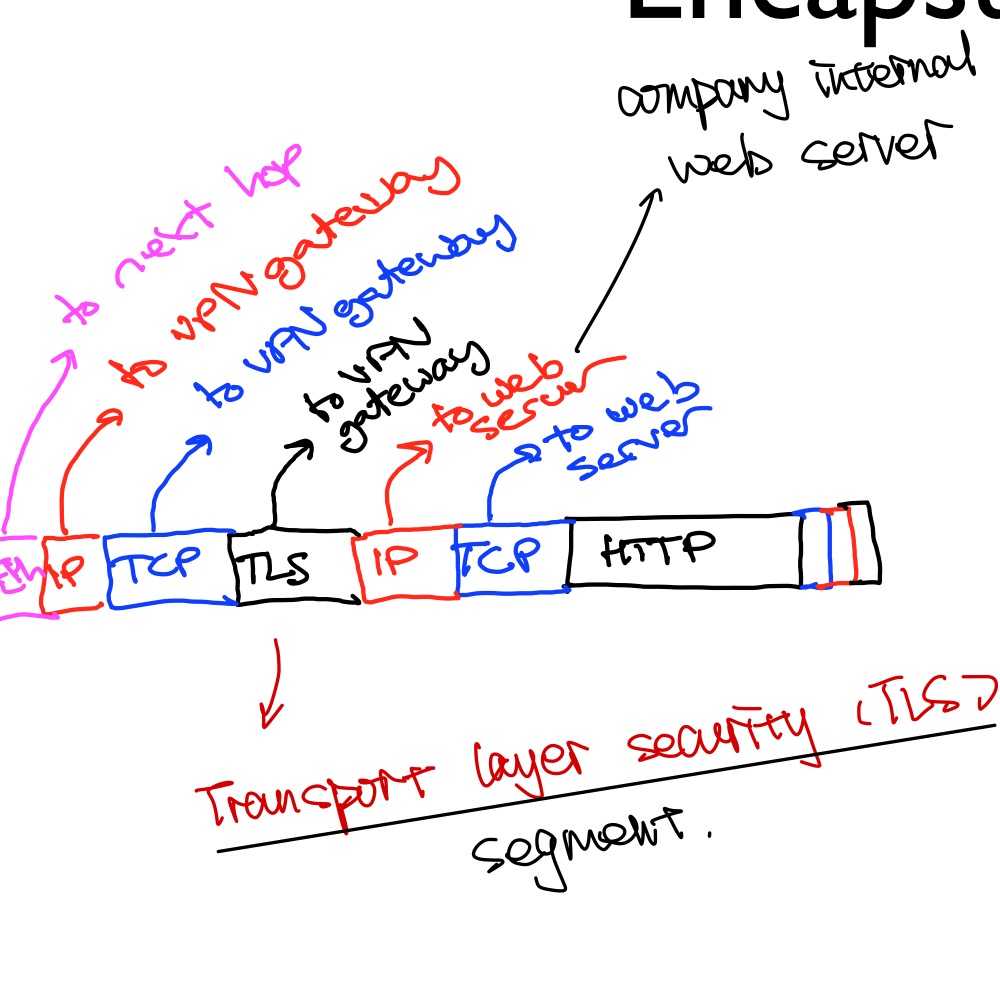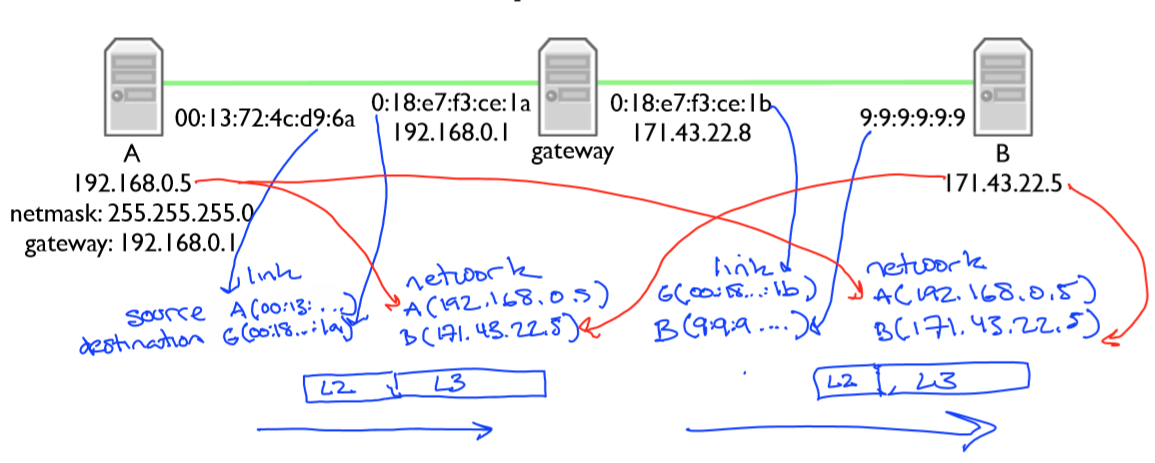cs244a-Introduction to Computer Networking-Unit1
Unit 1
学习目标:
- how an application use the Internet
- The structure of the Internet:The 4 layer model
- The Internet protocol(IP)
- Basic architectural ideas and principles:
- Packet switching
- Layering
- Encapsulation
1.1 A Day in the life of an Application
- Dominant model:
- bidrectional
- reliable byte stream connection
1. World Wide Web (HTTP)
- C/S架构
- 发送commands,接收responses
- request:"GET / HTTP/1.1"
- response: "HTTP/1.1 200 OK"
2. BitTorrent
- P2P架构
- break files into "pieces"
- 所有存有pieces file的client被称为swarm,client join and leave swarms
- tracker追踪swarm的成员,通过torrent file向一个tracker获取swarm中的client列表
- request: "GET list of clients in swarm"
- response: "200 OK list of clients"
3. Skype
- mixed架构
- 如果两个client能互联,就在client间建立连接--->P2P
- 如果有一方存在NAT:Client A-----Internet-----NAT---ClientB
- 由于NAT,B可以连接A,但A无法连接B
- A cannot open connection to B
- B在一个Rendezvous上注册,A向Rendezvous发送请求,Rendezvous转发请求给B,B主动和A建立连接
- 双方均存在NAT
- 通过一个Relay转发服务器作为中转,转发双方的消息
1.2 What the Internet is: The 4 Layer Internet Model
- Application:(http, bit-torrent)
- application-specific semantics
- Transport:(tcp, udp)
- guarantees correct, in-order delivery of data end-to-end
- controls congestion
- Network:(IP)
- must use the Internet Protocol(IP)
- best-effort attempt to deliver datagrams, no promises
- IP datagrams can get lost, out of order, and can be corrupted
- Link:(802.11, 3G, DSL, Ethernet)
- one-hop control
- delivers data over a single link between an end host and router, or between routers
two extra things need to know:
- IP is the "thin waist"
- the 7-layer OSI Model
- Application------http--------Application----7
- Application------ASCII-----Presentation--6
- Transport--------TCP-------Session--------5
- Transport--------TCP-------Transport------4
- Network----------IP----------Network--------3
- Link---------------Ethernet----Link------------2
- Link---------------Ethernet----Physical------1
1.3 What the Internet is: The IP service model
The Internet Protocol(IP)
- Transport Segment
- IP Datagram、Packets
- Link Frame
The IP service Model
Property Behavior Datagram Hop by hop routing Unreliable Packets might be dropped because of full wait queue Best effort Connectionless No per-flow state. Might be mis-sequenced why simple?
- faster, more streamlined and lower cost to build and maintain
- The end-to-end principle: implement features in the end hosts if possible
- Allows a variety of reliable(or not) services to be built on top
- Works over any link layer: IP makes very few assumptions about the link layer below
The IP service model
- Tries to prevent packets looping forever(TTL, time to live)
- Will fragment packets if they are too long
- Uses a header checksum to reduce chances of delivering datagram to wrong destination
- Allows for new versions of IP
- IPv4: 32 bit
- IPv6: 128 bit
- Allows for new options to be added to header
Quiz:
In an alternative to the Internet Protocol called "ATM" proposed in the 1990s, the source and destination address is replaced by a unique "flow" identifier that is dynamically created for each new end-to-end communication. Before the communication starts, the flow identifier is added to each router along the path, to indicate the next hop, and then removed when the communication is over. Which of the following statements are implications of this design? Check all that apply.
- (+)There is state in the network for every communication flow, rather than just for every destination.
- (-)If a link fails, there is no need to update any state in the network.
- (-)There must be a centralized controller to manage the insertion and removal of identifiers, as well as update them whenever a flow needs to be re-routed.
- (-)It means we no longer need a transport layer to reliably deliver correct, in-order data to applications.
1.4 A day in the life of a packet
- application: stream of data
- transport: segment of data
- network: packet of data
TCB Byte Stream
- "3-way handshaking"
- "SYN" "SYN/ACK" "ACK"
- To computer:network layer address: IP address
- To application:transport layer address: port
- web server: port 80
Inside the Stream
- hops: a link of two nodes
- access point
Inside Each Hop
- forwarding table
- key: IP address pattern, value: link
- longest prefix match
- default entry: least specific router
- mostly used in edge network
- forwarding table
1.5 Principle: Packet Switching
- Packet: A self-contained unit of data that carries information necessary for it to reach its destination.
- Flow: A collection of datagrams belonging to the same end-to-end communicaition, e.g. a TCP connection
- two consequences
- Simple: no per-flow state required, self-contained
- Efficient: allows flows to use all available link capacity
- Staticstical Multiplexing: taking a single resource and sharing it across multiple users in a probabilistic way
1.6 Principle: Layering
- layering: the organizaiton of a system into a number of separate functional components or layers
- Reasons for layering:
- Modularity
- Well defined service
- Reuse
- Separation of concerns
- Continuous improvement
- Peer to peer communications
1.7 Principle: Encapsulation
- layering:
- Transport: segment, inter-application communication
- Link: frame, inter-host communication on a shared link
- How layering manifests in data representation?
- layer N data is payload to layer N - 1
- allows to layer recursively
- Example: VPN(Virtual Private Network)
- VPN open a secure connection to a network you trust (like your office network)

- VPN open a secure connection to a network you trust (like your office network)
- Encapsulated payloads
- Help separation of concerns
- Help enforce boundaries/layering
- Simplify layer implementations
- Can not protect from malicious attacks
1.8 Byte order and Packet format
- Network byte order is big endian
- Helper functions: htons(), ntohs(), htonl(), ntohl()
- htons:"host to network short"
uint16_t http_port = 80; //Host order
if (packet->port == http_port) { ... //network vs. host order uint16_t http_port = 80;//Host order
uint16_t packet_port = ntohs(packet->port);
if (packet_port == http_port) { ... //OK
Quiz:
(+)The layout of a character string in memory is the same on big-endian and little-endian architectures.
1.9 IPv4 addresses and CIDR
- Goal of Internet Protocal(IP) Addresses
- Stitch many different networks together
- Need network-independent, unique address
- Internet Protocal, Version 4
- Layer 3(network) address
- 32 bits long(4 octets):a.b.c.d
- ex: 171.64.64.64
- Netmask: tells the device which IP addresses are local -- on the same link -- and which require going through an IP router.
if (A & netmask == B & netmask) {
on the same network
}
- 如果dest和src的掩码相同就不用经过路由器转发,可以直接发送
- smaller netmask means larger network
- Classes Inter-Domain Routing(CIDR, 无类别域间路由)
- 最初架构:将所有IP地址分成3类,每一类将IP地址分成两个部分,network和host,分别表示
- network part: administrative domain, such as MIT, BBN
- host part: which device within that network

- 当前CIDR架构:
- Rather than hava prefixes only of length 8, 16, and 24 bits, CIDR allows prefixes to be any number of bits
- Address block is pair: address, count
- All CIDR prefixes define a block of addresses that is a power of 2
- 因此描述IP地址时需要附带其掩码长度
- eg: 171.64.0.0/16 means any address in the range 171.64.0.0 to 171.64.255.255
- IPv4 Address Assignment
- IANA: Internet Assigned Numbers Authority
- Internet Corporation for Assignment of Names and Numbers(ICANN)'s job
- IANA gives out /8s(16百万个地址) to Regional Internet Registries(RIRs,每个大陆有一个,每个RIR有自己的分配政策)
- Ran out in Feburary 2011, 当只剩下最后5个/8s时,IANA给每个RIR一个/8
- IANA: Internet Assigned Numbers Authority
- 最初架构:将所有IP地址分成3类,每一类将IP地址分成两个部分,network和host,分别表示
- Longest prefix match(LPM)
- forwarding table is a set of CIDR entries
1.10 Address resolution protocol(ARP)
- Layers of Address
- ARP: The mechanism by which the network layer can discover the link address associated with a network address it's directly connected.
- A link address describes a particular network card. eg: Ethernet has 48 bit addresses
- Host: 171.67.76.65
- Interface: 00:13:72:4c:d9:6a
- Addressing Problem
- 因为子网掩码的概念,router或gateway通常有多个interface,每个接口(interface)对应一个识别自身网卡link address以及一个识别host主机的network layer address,例如下图中的网关(gateway),具有两个network cards:

- 当A向B发送IP packet时,通过子网掩码知道A和B不在一个网络中,因此首先需要经过gateway,A虽然知道gateway的IP地址,但是不一定知道gateway的link address
- 因为子网掩码的概念,router或gateway通常有多个interface,每个接口(interface)对应一个识别自身网卡link address以及一个识别host主机的network layer address,例如下图中的网关(gateway),具有两个network cards:
- Encapsulation
- 在IP层,Ip packet只需要知道dest和source host的ip地址
- 在Link layer,负责一段链路,因此每一段链路的link layer address
- Address Resolution Protocol
- request-reply protocal
- Each node keeps a cache of mappings from IP addresses on its network to link layer addresses
- 请求发送方式:广播(Link address全1,48个1)
- 请求中包含请求者的ip和link address,因此所有收到该ARP请求的节点都可以insert or refresh a mapping from their cache
- 响应发送方式:协议要求unicast(单播),通常实现为广播
- 节点仅响应对他们自己的请求
- 因此,如果一个节点断开连接或crash,当所有mappings过期后才算离开网络
- mappings存储时间取决于设备,Mac OSX保持20min。Cicso设备保持4hours
- 节点进入网络也可以发送gratuitour(免费) ARP packets,requesting non-existent mappings,in order to advertise themselves on a network
- ARP Packet Format(RFC826)

- Hardware: what link layer this request or response is for
- Protocol: what network protocol this request is for
- length fields: 长度
- opcode:packet类型是发送还是响应
cs244a-Introduction to Computer Networking-Unit1的更多相关文章
- A Simple Introduction To Computer Networking
Most networking discussions are a jumble of acronyms. Forget the configuration details - what are th ...
- MIT Introduction to Computer Science and Programming (Lesson one )
MIT Introduction to Computer Science and Programming (Lesson one ) 这篇文是记载 MIT 计算机科学及编程导论 第一集 的笔记 Les ...
- Computer Networking: A Top Down Approach
目录 Chapter 1: Computer Networks and the Internet 1. What is the Internet? 2. The Network Edge 3. The ...
- Note 2 for <Pratical Programming : An Introduction to Computer Science Using Python 3>
Book Imformation : <Pratical Programming : An Introduction to Computer Science Using Python 3> ...
- Note 1 for <Pratical Programming : An Introduction to Computer Science Using Python 3>
Book Imformation : <Pratical Programming : An Introduction to Computer Science Using Python 3> ...
- Introduction to Computer Science and Programming in Python--MIT
学习总结--(Introduction to Computer Science and Programming in Python--MIT) 导论 主题 重新利用数据结构来表达知识 理解算法的复杂性 ...
- Introduction to Computer Networks(网络架构与七层参考模式)
Network Connectivity 1. Important terminologies 1) Link 设备连接的连线.Link本身既可以是有线的,也可以是无线的. 2) Node 设备.电脑 ...
- An Introduction to Computer Thinking
1.Die Grundlage des Computers 1.1 Binärzahl in die Dezimalzahl umsetzen Bereiten nach Gewicht,dann b ...
- MITx: 6.00.1x Introduction to Computer Science and Programming Using Python Week 2: Simple Programs 4. Functions
ESTIMATED TIME TO COMPLETE: 18 minutes We can use the idea of bisection search to determine if a cha ...
- edX MITx: 6.00.1x Introduction to Computer Science and Programming Using Python 课程 Week 1: Python Basics Problem Set 1 Problem 3
Assume s is a string of lower case characters. Write a program that prints the longest substring of ...
随机推荐
- RESTful规范与django编写restful接口
一.什么是RESTful规范 ①REST与技术无关,代表的是一种软件架构风格,REST是Representational State Transfer的简称,中文翻译为“表征状态转移” ②REST从资 ...
- python 安装-ERROR---Unable to find vcvarsall.bat
系统配置:Windows10 x64, Visual Studio 2017, Python2.7.1 报错信息:error: Unable to find vcvarsall.bat 报错原因:在生 ...
- python学习之路(11)
切片 取一个list或tuple的部分元素是非常常见的操作.比如,一个list如下: >>> list=['zh','cn','sqlmap','nmap','znamp'] 取前3 ...
- Vue CLi3入门
摘自:https://www.jianshu.com/p/cf9b56efd3b8 Vue CLi3入门 12018.11.15 14:16:17字数 1222阅读 8895 地址 Vue CLi3 ...
- Java常考面试题整理(五)
81.RMI中的远程接口(Remote Interface)扮演了什么样的角色? 参考答案: 远程接口用来标识哪些方法是可以被非本地虚拟机调用的接口.远程对象必须要直接或者是间接实现远程接口.实现了远 ...
- Linux-Ubuntu目录
ubuntu没有盘符这个概念,只有一个根目录/,所有文件都在它下面 /:根目录,一般根目录下只存放目录,在Linux下有且只有一个根目录.所有的东西都是从这里开始.当你在终端里输入“/home”,你其 ...
- failed to create cublas handle: CUBLAS_STATUS_ALLOC_FAILED 错误解决方法
解决: config = tf.ConfigProto() config.gpu_options.allow_growth = True session = tf.Session(config=con ...
- JavaEE-实验二 Java集合框架实验
该博客仅专为我的小伙伴提供参考而附加,没空加上代码具体解析,望各位谅解 1. 使用类String类的分割split 将字符串 “Solutions to selected exercises ca ...
- wpf prism4 出现问题:无法加载一个或多个请求的类型。有关更多信息,请检索 LoaderExceptions 属性。
WPF Prism 框架 程序 出现 问题: 无法加载一个或多个请求的类型.有关更多信息,请检索 LoaderExceptions 属性. 1.开始以为是配置的问题,找了半天,最后原来是有个依赖类库没 ...
- 对redis的一些理解
缓存就是在内存中存储的数据备份,当数据没有发生本质变化的时候,我们避免数据的查询操作直接连接数据库,而是去 内容中读取数据,这样就大大降低了数据库的读写次数,而且从内存中读数据的速度要比从数据库 ...
